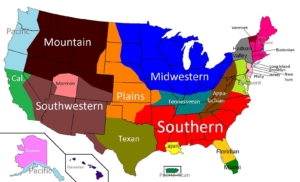
English Accents around the World
Scroll down for examples of accents.
How do accents differ?
Rhoticity
In rhotic accents, speakers pronounce the ‘r’ sound in words, wherever it appears. In the standard American accent and many regional British accents including Scottish, speakers would pronounce the ‘r’ in words like ‘car’ and ‘park’.
In non-rhotic accents, like the standard British RP, speakers don’t pronounce the ‘r’ unless it is followed by a vowel. So, speakers would not pronounce the ‘r’ in words like ‘car’ and ‘park’, but they would pronounce it in words like ‘carrot’.
Vowel sounds
Some accents have distinct vowel sounds that differ from others. For example the ‘a’ sound in words like ‘bath’ and ‘dance’ varies between accents. There is a big north/south divide in Britain with the pronunciation of the ‘a’ in many words. Accents also differ the pronunciation of dipthongs.
Consonant sounds
Accents may vary in the pronunciation of consonant sounds. For instance, the ‘t’ sound may be pronounced differently in standard American and standard British accents, and a lot of accents drop the ‘t’ sound completely. Similarly, the pronunciation of the ‘th’ sounds (as in ‘thin’ or ‘this’) can vary between accents.
Rhythm
Rhythm is created by the pattern of stressed and unstressed syllables in speech. Some accents have a more evenly-paced rhythm, while others emphasise certain syllables more strongly. Some accents, influenced by African American Venacular English (AAVE) and Caribbean English, have a distinct rhythmic pattern compared to others.
Stress Patterns
Accents can differ in the placement of stress within words and sentences. For example, some accents place primary stress on the first syllable of words, while others place the primary stress on the second syllable. There are numerous examples of this in standard American compared with standard British accents.
‘address’
Standard American English (SAE): AD-dress
Standard British English (SBE): ad-DRESS
‘garage’
SAE: ga-RAGE
SBE: GAR-age
‘controversy’
SAE: CON-tro-ver-sy
SBE: con-TRO-ver-sy
Intonation
Intonation refers to the rise and fall of pitch in speech. Different accents can have distinct intonation patters, which can affect the overall melody of speech. For instance, some accents (like standard Australian) have a rising intonation at the end of declarative sentences, which can sound like questions to English speakers with other accents. Welsh English accents are considered particularly melodic due to their intonation patterns.
Some International English Accents
This is not an exhaustive list

The South Indian English Accent
The Singaporean English Accent
International Podcasts for English Language Learners
BBC Learning English Podcasts from the UK
Voice of America (VOA) Podcasts from the USA
Special Broadcasting Service (SBS) Podcast from Australia
Canadian Broadcasting Service (CBS) Podcasts from Canada
Kiwi English Podcast from New Zealand
Learn English with Everest Podcast from Ireland
If you’re interested in accents, have a look at my post on ‘English Accents and Dialects: An Introduction‘, ‘English Accents Around the UK‘.


